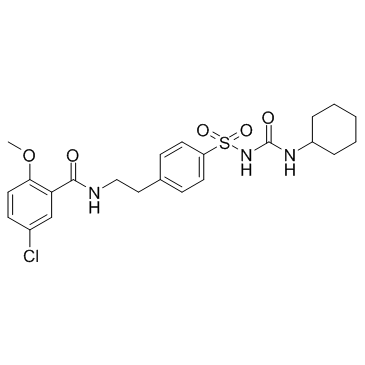

格列苯脲结构式

|
常用名 | 格列苯脲 | 英文名 | Glibenclamide |
|---|---|---|---|---|
| CAS号 | 10238-21-8 | 分子量 | 494.004 | |
| 密度 | 1.4±0.1 g/cm3 | 沸点 | 705.7±70.0 °C at 760 mmHg | |
| 分子式 | C23H28ClN3O5S | 熔点 | 173-175°C | |
| MSDS | 中文版 美版 | 闪点 | 380.6±35.7 °C |
|
Toll-like receptor 4-interacting SPA4 peptide suppresses the NLRP3 inflammasome in response to LPS and ATP stimuli.
J. Leukoc. Biol. 98 , 1037-48, (2015) Inflammation is induced because of interplay among multiple signaling pathways and molecules during infectious and noninfectious tissue injuries. Crosstalk between Toll-like receptor-4 signaling and the neuronal apoptosis inhibitor protein, major histocompati... |
|
|
Cheminformatics analysis of assertions mined from literature that describe drug-induced liver injury in different species.
Chem. Res. Toxicol. 23 , 171-83, (2010) Drug-induced liver injury is one of the main causes of drug attrition. The ability to predict the liver effects of drug candidates from their chemical structures is critical to help guide experimental drug discovery projects toward safer medicines. In this st... |
|
|
Translating clinical findings into knowledge in drug safety evaluation--drug induced liver injury prediction system (DILIps).
J. Sci. Ind. Res. 65(10) , 808, (2006) Drug-induced liver injury (DILI) is a significant concern in drug development due to the poor concordance between preclinical and clinical findings of liver toxicity. We hypothesized that the DILI types (hepatotoxic side effects) seen in the clinic can be tra... |
|
|
The Japanese toxicogenomics project: application of toxicogenomics.
Mol. Nutr. Food. Res. 54 , 218-27, (2010) Biotechnology advances have provided novel methods for the risk assessment of chemicals. The application of microarray technologies to toxicology, known as toxicogenomics, is becoming an accepted approach for identifying chemicals with potential safety proble... |
|
|
Chemical genetics reveals a complex functional ground state of neural stem cells.
Nat. Chem. Biol. 3(5) , 268-273, (2007) The identification of self-renewing and multipotent neural stem cells (NSCs) in the mammalian brain holds promise for the treatment of neurological diseases and has yielded new insight into brain cancer. However, the complete repertoire of signaling pathways ... |
|
|
Paroxetine decreased plasma exposure of glyburide partly via inhibiting intestinal absorption in rats.
Drug Metab. Pharmacokinet. 30 , 240-6, (2015) Accumulating evidences have shown that diabetes is often accompanied with depression, thus it is possible that oral antidiabetic agent glyburide and antidepressive agent paroxetine are co-administered in diabetic patients. The aim of this study was to assess ... |
|
|
Identification of CYP3A7 for glyburide metabolism in human fetal livers.
Biochem. Pharmacol. 92(4) , 690-700, (2014) Glyburide is commonly prescribed for the treatment of gestational diabetes mellitus; however, fetal exposure to glyburide is not well understood and may have short- and long-term consequences for the health of the child. Glyburide can cross the placenta; feta... |
|
|
Maternal-fetal disposition of glyburide in pregnant mice is dependent on gestational age.
J. Pharmacol. Exp. Ther. 350(2) , 425-34, (2014) Gestational diabetes mellitus is a major complication of human pregnancy. The oral clearance (CL) of glyburide, an oral antidiabetic drug, increases 2-fold in pregnant women during late gestation versus nonpregnant controls. In this study, we examined gestati... |
|
|
Interference with distinct steps of sphingolipid synthesis and signaling attenuates proliferation of U87MG glioma cells.
Biochem. Pharmacol. 96 , 119-30, (2015) Glioblastoma is the most common malignant brain tumor, which, despite combined radio- and chemotherapy, recurs and is invariably fatal for affected patients. Members of the sphingolipid (SL) family are potent effectors of glioma cell proliferation. In particu... |
|
|
Neural computational prediction of oral drug absorption based on CODES 2D descriptors.
Eur. J. Med. Chem. 45 , 930-40, (2010) A neural model based on a numerical molecular representation using CODES program to predict oral absorption of any structure is described. This model predicts both high and low-absorbed compounds with a global accuracy level of 74%. CODES/ANN methodology show... |